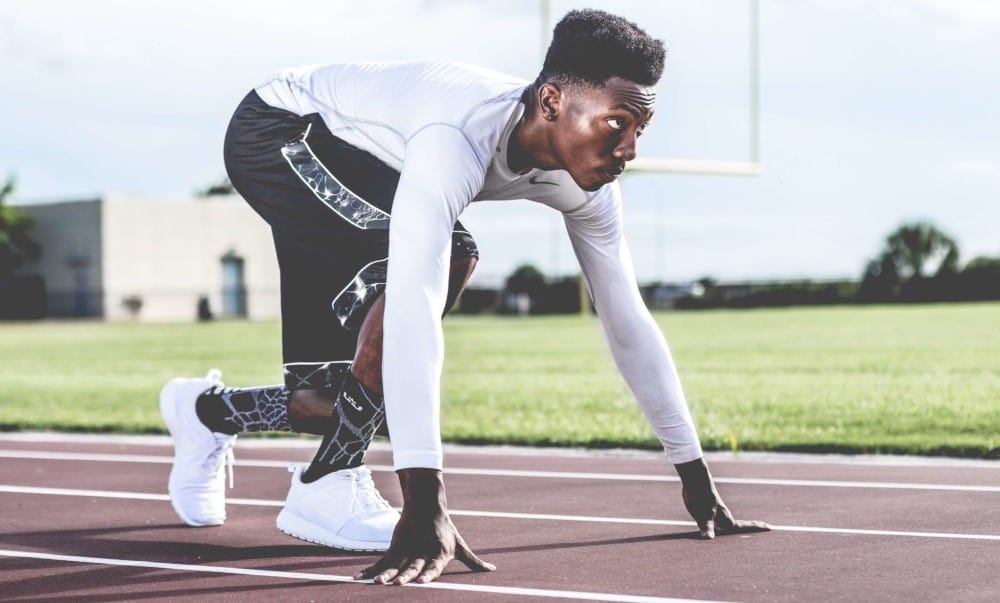Some get caught earlier, others later. Presumably, each one of us can tell his own story on injuries – and even if you’ve had the luck and been spared so far, it’s unlikely anyone will manage to remain completely injury free throughout his entire training career.
But what is most important when it comes to joint health for athletes?

There are a variety of ways to reduce the likelihood of injury to an acceptable level. If it does happen then it is up to you to take the right measures to promote recovery and return to training as quickly as possible.
In this article, you’ll learn more about how to better protect your joint as an athlete and how to heal existing joints more effectively, so they do not keep you from training for too long.
4 Tips for Healthy Joints as an Athlete
Tip # 1: Leave your ego at home
Probably the most common cause of unnecessary sports injuries is your own ego – especially in connection with injuries, false ambition in the gym is often your biggest enemy.
Stereotypically this would be the following situation, which probably every exerciser himself could observe at least once in the studio every day:
A young, rather gracefully built man enters the training area and loads the barbell with a decent load of weights. It’s a tough situation: You don’t want to be rude but the guy is literally looking like he’s about to break his back.
Although one should never deduce the physical power from the optics, in such cases the intuition is often right. And if the individual is not a well-trained powerlifter and tribe member in the aforementioned gym, most of us will be right with their prognosis – the dumbbell is moved by said beginner with such a bad execution over half the range of motion, it already hurts looking. The desired target musculature usually makes only a manageable contribution to coping with the weight.
Even if such a procedure may be fine for a while, it can be said that injuries are almost inevitable. So why not take weight off the bar and do the exercise technically clean?
Okay, that may not look as impressive as before, but you should basically ask yourself why you even go to the gym. To impress the others? Or rather to become stronger and more muscular yourself?
Believe me: First of all, you will not impress anyone in the studio anyway, unless you’re a +100 kg beast that moves inhumane weights and secondly, you will never make progress because you a) will not b.) increase the chance of a disproportionate amount of injuring yourself.
So leave your ego at home when you go to training. In this way, you will not only stay (longer) injury-free but also train the correct target musculature of the exercise to a more intense extent – which, with appropriate progression, should also lead to far more muscle growth, Two birds with one stone!
The same applies to re-enter training after an injury has knocked you out: consciously get in with less weight than you did before the break. Otherwise, you will enjoy a new injury much faster than you would like.
Tip # 2: Keep an eye on your hydration
Most athletes will be aware of the importance of having enough fluid to build strength and muscle. Yet, only a handful of people come to mind about injuries. But even here an adequate supply of the body with fluid plays an important role – and I explain to you why!
In addition to preventing cramping, which contributes to the proper hydration, it also helps to protect the joints. This is especially clear when you realize that the synovial fluid, which ensures a comfortable sliding of the articular surfaces, can absorb shock, as well as supplies the articular cartilage with nutrients, about 94% consists of water. That insufficient hydration is not beneficial here, should be obvious.
But how do we ensure that we supply enough fluid to our body?
Some recommendations refer to body weight but do not take into account individual circumstances, such as the training amount of a person or what climatic conditions it is exposed. First and foremost, these recommendations can only serve as a guide.
A much more suitable method is, therefore, the monitoring of your own urine color. If this is light or even transparent, it can be assumed that there is sufficient hydrogenation of your own body, while rather dark-colored urine is a sign of dehydration.

Tip # 3: Use Soft Tissue Therapy in Your Routine
Soft Tissue therapy can be performed in many ways. Probably the most common and well-known are the loosening of myofascial and the treatment of so-called “trigger-points”.
The big advantage of these therapies is an increased blood flow, which in addition benefits your regeneration (improved nutrient supply of the musculature + removal of metabolic products) as well as an increase of your mobility.
The latter is especially helpful if your discomfort is due to immobility or hardening of one or more muscles. So soft tissue therapy can also allow you to perform exercises over a greater range of motion, which should have a positive effect in terms of muscle building if your range of motion was previously limited. Increased blood flow can also improve the regeneration of passive structures, which are usually poorly supplied with blood, such as the tendons. It is the tendons whose regeneration lags behind those of the musculature, which is why progressive weight training often causes problems when the weights are raised a bit too fast.
Basically, it does not matter too much which exact form of treatment you choose. It is recommended to take some time for the therapy daily or only on training-free days. However, it is not recommended to use it immediately before a training session because a reduced muscle tone in the course of therapy is also accompanied by a possible reduction in performance.
Tip # 4: Use the right supplements
In addition to the methods already presented, there are also various dietary supplements that can protect you from injury or accelerate the healing of existing ailments. Decide for yourself which resources are worth a try and orientate yourself according to your available budget
Omega 3 fatty acids (EPA & DHA)
The first supplement to be mentioned in this series is an omega-3 supplement of animal origin such as fish oil. The contained fatty acids EPA (eicosapentaenoic acid) and DHA (docosahexaenoic acid) support the lubrication and suppleness of the joints and are able to reduce inflammatory processes. In the context of inflammatory processes, especially the ratio of Omega-6 to Omega-3 fatty acids that you consume with food is crucial (if you want to know more about the topic, you should read our detailed article on an Optimal Omega 3 to read Omega 6 ratio).
The regular intake of greasy fish reduces the amount that you need from fish oil as a dietary supplement and depending on the amount and regularity can even lead to the fact that you do not need additional supplementation.
The optimal ratio of omega-6 to omega-3 is often given as 2: 1 to 5: 1, with the average diet in industrialized countries now at a 20: 1 ratio. So it’s not unlikely that you too will benefit from supplementing with fish oil.

Curcumin
Another supplement that can help you deal with injuries is curcumin. Like fish oil, curcumin also has anti-inflammatory properties. Curcumin is found mainly in the spice turmeric, in small quantities but also in garlic.
Due to the poor bioavailability, the additional intake of black pepper extract (piperine) or other substances that improve the intake of curcumins is recommended, with black pepper already being added to most curcumin supplements.
Curcumin unfolds the anti-inflammatory effect primarily in the intestines.
The dosage should be between 80mg and 500mg in terms of sports injuries and should include an intake-enhancing substance. Studies have shown that an overdose with fatal consequences is achieved only from much higher amounts and can hardly be achieved by conventional intake schemes.
Glucosamine + Chondroitin
The most popular supplements in the field of injuries and joint health are probably chondroitin + glucosamine (and possibly even MSM as an addition). Due to synergy effects, both are often supplemented in combination.
Glucosamine slows down the breakdown of joint mass and the onset of osteoarthritis and inhibits its symptoms. Although scientific research is not unambiguous, based on the experience of many people is based on a reduction of joint swelling, pain, and stiffness, which is accompanied by an addition of chondroitin.
The recommended dosage for glucosamine is three daily doses of 300-500mg with meals. Chondroitin should also be taken with meals either as a single dose of 1000-1200mg or divided into three doses.
Other possible additions
In addition to the above, there are a number of other supplements that have not yet been scientifically proven in terms of sports injuries, while experience reports still suggest certain effectiveness. These substances include u.a. B. Diffusa, Rosehip, Cissus, Ginger and Boswellia serrata.
Here everyone should decide for himself whether he takes money for such means. Against this background, it should not be forgotten that the so-called placebo effect can also produce significant effects.
Conclusion: Joint health for Athletes
In weight training and bodybuilding, the credo is “who is not injured, can make progress”, so you should focus on staying injury free. The health of your joints plays an important role and every athlete who has had joint pain or injury before can confirm this!
While the 4 tips presented here cannot give you a 100% guarantee of an injury-free training career, they can at least serve as a necessary guide to promoting joint health and, should you ever have any problems with meaningful support for regeneration.
Use these tips to your advantage and always remember: Stay realistic and train for progression and not for your ego!
Cheers,
Sam




